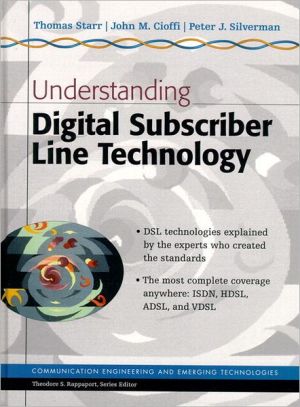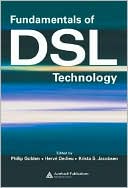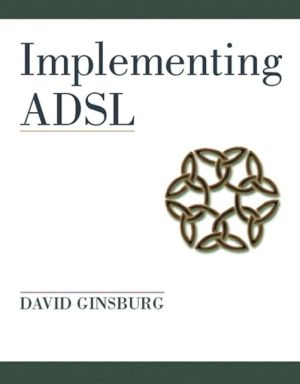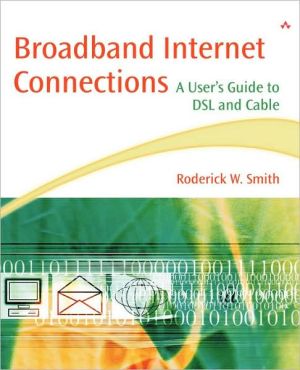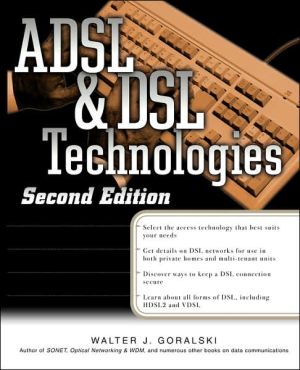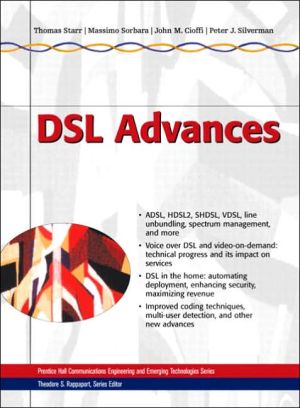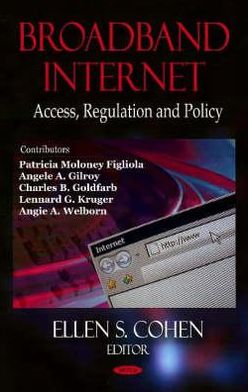Understanding Digital Subscriber Line Technology
78054-4\ DSL technologies explained by the experts who created the standards\ The most complete coverage anywhere: ISDN, HDSL, ADSL, and VDSL\ The basic infrastructure for the global broadband network of the future is already in place in most homes and offices. Ordinary telephone lines can provide low-cost, high-volume access to the exploding world of telecommunications services that users increasingly rely on.\ Now, leading experts in the field have come together to share their insights in a...
Search in google:
78054-4DSL technologies explained by the experts who created the standardsThe most complete coverage anywhere: ISDN, HDSL, ADSL, and VDSLThe basic infrastructure for the global broadband network of the future is already in place in most homes and offices. Ordinary telephone lines can provide low-cost, high-volume access to the exploding world of telecommunications services that users increasingly rely on.Now, leading experts in the field have come together to share their insights in a single volume, explaining the past, present, and future of all the DSL technologies. Understanding Digital Subscriber Line Technology: Covers the entire DSL family, from ISDN at 144 kb/s to VDSL at 52 Mb/s Details DSL at all layers of protocol, with special emphasis on the physical layer Discusses applications from both provider and end-user points of view Gives an insider's view of the telecommunications standards process Key standards are explained, including transmission line characteristics, data rates, modulation and coding methods, operations procedures, transconvergence layers, protocols, and network architectures.With its inside track and extensive level of detail, Understanding Digital Subscriber Line Technology will be indispensable to telecom and datacom engineers at every level. It also offers a comprehensible explanation of issues in this growing field to managers, marketing experts, and consumers of DSL technology. Booknews DSL technology promises to bring broadband, high-speed network access to the ordinary consumer through preexisting telephone lines. This volume presents a detailed overview of the technology, its applications, and how it can be best utilized in the future. Topics include basic digital transmission methods; loop impairments, solutions, and DMT; network architecture and regulation; and the DSL standards. Includes a CD-ROM containing drafts of the applicable standards and top papers in the field. Annotation c. by Book News, Inc., Portland, Or.
Visionaries have spoken of a future where the common person has instantaneous access to data spread around the globe. Engaging in a live videoconference, or perhaps watching a personalized newscast are just two of examples of many. For this vision to become reality, a global broadband information infrastructure must be built that provides low-cost access to the consumers and sources of information. What connects to virtually every home and business in the industrialized world? Phone lines connect to 700 million sites today. Data rates of several kilobits per second are possible over phone lines using dial-up modems. This is enough to spark the appetite of the Internet surfer but is not nearly enough to satisfy the desire for immediate information on demand. Similarly, video and audio applications at dial-up modem data rates leave users demanding more.\ Digital subscriber line (DSL) technology enables high-speed digital transmission on conventional telephone lines. A global broadband information infrastructure based on telephone lines is emerging, and it relies on DSL technology. The transformation of the telephone line access has begun; it is progressing with the addition of over one billion U.S. dollars worth of DSL equipment each year. Accomplishing the impossible is an engineer's greatest reward. Digital subscriber line development has been most rewarding. In 1975, it was believed that 20 kb/s was the highest data rate that could be transmitted via telephone lines. Then, breakthrough concepts in digital transmission were enabled by enormous advances in very-large-scale integrated (VLSI) circuits and digital signal processing (DSP). Transceiver designs of breathtaking complexity (at that time) provided 144 kb/s basic rate ISDN (BRI) transport via most telephone lines. Experts then said that this was very near the capacity limit of telephone lines. This barrier was demolished by the 1.5 Mb/s high bit rate DSL (HDSL). The breakthrough cycle was repeated by 6 Mb/s asymmetric DSL (ADSL), and then 52 Mb/s very-high bit rate DSL (VDSL).\ This book explains and details the key concepts for DSL technology and its applications. The reader will attain a strong familiarity with the crucial aspects and technical jargon of the DSL field. The scope encompasses applications, network architecture, network management, network operations, communications protocols, standards, regulatory issues, and the underlying technologies. This book was written to assist engineers and marketing managers - whether new to DSLs or experts in need of a convenient reference. Background regarding voice-band transmission via telephone lines may be found in the excellent books by Witham Reeves on subscriber loops.\ Acknowledgments\ The authors thank Jim Loehndorf for assistance with the sections on data communications protocols, and Kim Maxwell for providing his input regarding voice-band modems and other sections.\ The authors would also like to sincerely thank Dr. Kiho Kim, Richard Goodson, and Dr. Martin Pollakowski for their review of this material and their helpful comments and suggestions.\ The second author, John Cioffi, especially would like to thank the following people (in alphabetical order) for their significant discussions and direct assistance on specific topics of this book: Mike Agah, John Bingham, Jacky Chow, Peter Chow, John Cook, Joice DeBolt, Kevin Foster, Mathias Friese, Richard Goodson, Werner Henkel, Atul Salvekar, Jose Tellado, Po Tong, Craig Valenti, Jean-Jacques Werner, and George Zimmerman. He further wishes to thank Dr. Joe Lechleider for enticing him into DSL in 1987, and thanks beyond measure the outstanding technical staff of Amati (1989-1997, now Texas Instruments), and the first to believe: his past and present students at Stanford.\ Thanks also go out to Steve Blackwell and Kevin Schneider of Adtran, who kindly offered the use of their good summary of HDSL2 work in the T1E1.4 Working Group. The first author, Tom Starr, has had the pleasure of chairing the T1E1.4 Working Group for over ten years. Thanks to the professionalism, dedication, and expertise of its members, T1E1.4 has done more than merely write the industry's DSL standards. Multidisciplinary collaboration has allowed T1E1.4 to set the industry's objectives and chart the course to meeting these objectives. There have been moments of agony and disappointment but, on the whole, serving as T1E1.4 chair has been rewarding. Thank you, members of T1E1.4, for being the world's foremost creators of DSL technology.\ The views expressed in this book are those of the authors and do not necessarily reflect the views of their employers or the organizations in which the authors hold office.\ Thomas Starr John M. Cioffi Peter Silverman
PrefaceAcknowledgmentsAbout the AuthorsCh. 1DSL Fundamentals1Ch. 2Types of DSLs23Ch. 3Twisted-Pair Transmission53Ch. 4Comparison with Other Media133Ch. 5Transmission Duplexing Methods139Ch. 6Basic Digital Transmission Methods147Ch. 7Loop Impairments, Solutions, and DMT183Ch. 8Initialization, Timing and Performance297Ch. 9Operations, Administration Maintenance, and Provisioning355Ch. 10DSL in the Context of the ISO Reference Model363Ch. 11ADSL: The Bit Pump369Ch. 12ATM Transmission Convergence on ADSL381Ch. 13Frame-Based Protocols over ADSL385Ch. 14ADSL in the Context of End-to-End Systems391Ch. 15Network Architecture and Regulation411Ch. 16Standards419App. A Glossary433App. BSelected Standards and Specifications443App. CSelected T1E1.4 Contributions and ADSL Forum Technical Reports (found on CD-ROM)447Index465
\ BooknewsDSL technology promises to bring broadband, high-speed network access to the ordinary consumer through preexisting telephone lines. This volume presents a detailed overview of the technology, its applications, and how it can be best utilized in the future. Topics include basic digital transmission methods; loop impairments, solutions, and DMT; network architecture and regulation; and the DSL standards. Includes a CD-ROM containing drafts of the applicable standards and top papers in the field. Annotation c. by Book News, Inc., Portland, Or.\ \
